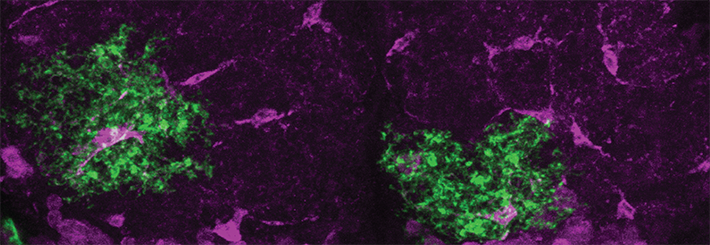
Breadcrumb
- News and Events
- News
- Content
- Recovering from sleep deprivation: What is the role of astrocytes?
null Recovering from sleep deprivation: What is the role of astrocytes?
A new RI-MUHC study uses sleep-deprived fruit flies to study regulation of rebound sleep
Source: RI-MUHC. How the brain controls the need for—and acquisition of—sleep is an area of intense research. Sleep is essential for our physical and mental health. A lack of sleep can lead to reduced energy and an inability to concentrate, and it is often linked to serious outcomes, such as chronic illness and mood disorders.
While neurons in the brain are known to control sleep directly, another specific type of brain cell, the astrocyte, is also important for sleep regulation. So far, it has been unclear whether astrocytes are involved in regulating the need for recovery sleep after a sleep-deprived night, also known as rebound sleep.
In a paper published this month in the journal eLife, researchers at the Research Institute of the McGill University Health Centre (RI-MUHC) used sleep-deprived fruit flies to investigate the role of astrocytes in regulating rebound sleep. The research team was led by Don van Meyel, PhD, a senior scientist at the Research Institute of the McGill University Health Centre (RI-MUHC), in collaboration with the lab of Dr. Amita Sehgal of the Perelman School of Medicine at the University of Pennsylvania.

“We focused on an enzyme called AANAT1, which had been known previously to break down the important chemical signals serotonin and dopamine,” says van Meyel, who is a member of the Brain Repair and Integrative Neuroscience Program (BRaIN) and director of the Centre for Translational Biology at the RI-MUHC.
Sejal Davla, PhD, the study’s lead author and a former PhD student at the RI-MUHC, discovered AANAT1 to be expressed in brain astrocytes and found, as well, that AANAT1 levels in astrocytes peaked at the beginning of the night, declined as the night went on, and returned to normal levels by morning.

Fruit flies were kept awake for up to 12 hours overnight. The next morning, researchers measured brain serotonin and dopamine levels in the flies, using a method developed by Ed Daly, Lorne Taylor and the team at the Proteomics Platform of the RI-MUHC. “The AANAT1 enzyme had the effect of limiting the accumulation of serotonin and dopamine in the brain upon sleep deprivation,” says Davla.
Fruit flies have emerged as an important genetic model for studying the neurobiology of sleep control. Sleep is measured in flies by continuous monitoring of their movements, and when the researchers sleep-deprived fruit flies whose astrocytes were rendered unable to produce the AANAT1 molecule, the flies took much more rebound sleep during the day to make up for lost sleep at night. “These results show that both astrocytes and AANAT1 play a crucial role in sleep homeostasis,” says Davla.
“Molecules belonging to the AANAT family exist in both flies and humans, and these results could have important implications for the science of sleep,” says van Meyel. “This study paves the way for understanding the mechanisms of sleep homeostasis that are similar in both organisms, and may, in the future, help to identify sleep drugs that target astrocytes and the molecules they express.”
About the study:
Sejal Davla, Gregory Artiushin, Yongjun Li, Daryan Chitsaz, Sally Li, Amita Sehgal, Donald J van Meyel. AANAT1 functions in astrocytes to regulate sleep homeostasis. eLife 2020;9:e53994 DOI: 10.7554/eLife.53994
This work was supported by the Canadian Institutes of Health Research (CIHR), the Natural Sciences and Engineering Research Council of Canada, the Canada Foundation for Innovation, the Howard Hughes Medical Institute, and the National Institutes of Health (NIH).
October 22, 2020